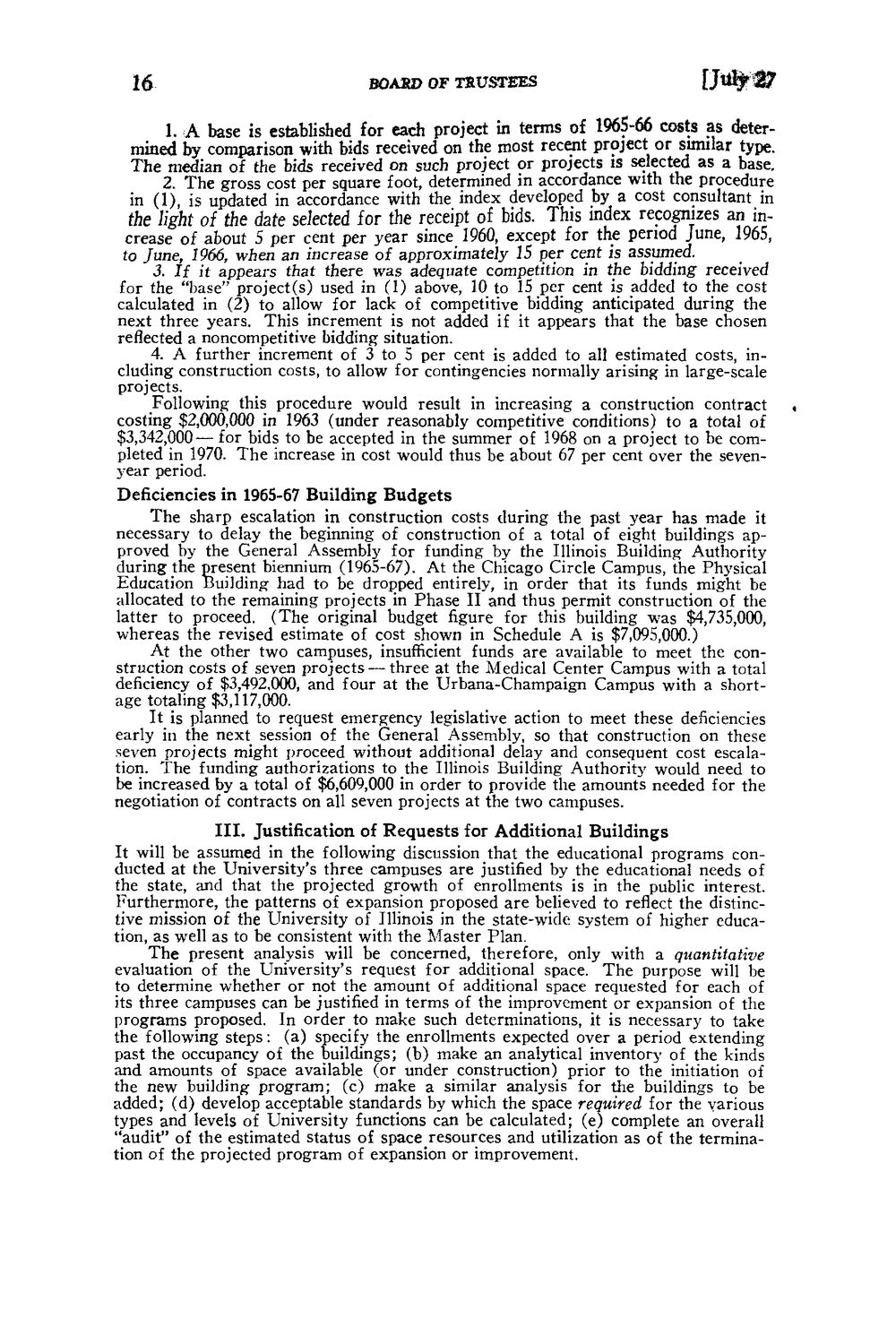| |
| |
Caption: Board of Trustees Minutes - 1968
This is a reduced-resolution page image for fast online browsing.

EXTRACTED TEXT FROM PAGE:
16 BOARD OF TSUSTEES [Jl%1^ 1. A base is established for each project in terms of 1965-66 costs as determined by comparison with bids received on the most recent project or similar type. The median of the bids received on such project or projects is selected as a base. 2. The gross cost per square foot, determined in accordance with the procedure in (1), is updated in accordance with the index developed by a cost consultant in the light oi the date selected for the receipt of bids. This index recognizes an increase of about 5 per cent per year since I960, except for the period June, 1965, to June, 1966, when an increase of approximately 15 per cent is assumed. 3. If it appears that there was adequate competition in the bidding received for the "base" project(s) used in (I) above, 10 to 15 per cent is added to the cost calculated in (2) to allow for lack of competitive bidding anticipated during the next three years. This increment is not added if it appears that the base chosen reflected a noncompetitive bidding situation. 4. A further increment of 3 to 5 per cent is added to all estimated costs, including construction costs, to allow for contingencies normally arising in large-scale projects. Following this procedure would result in increasing a construction contract costing $2,000,000 in 1963 (under reasonably competitive conditions) to a total of $3,342,000— for bids to be accepted in the summer of 1968 on a project to be completed in 1970. T h e increase in cost would thus be about 67 per cent over the sevenyear period. Deficiencies in 1965-67 Building Budgets The sharp escalation in construction costs during the past year has made it necessary to delay the beginning of construction of a total of eight buildings approved by the General Assembly for funding by the Illinois Building Authority during the present biennium (1965-67). At the Chicago Circle Campus, the Physical Education Building had to be dropped entirely, in order that its funds might be allocated to the remaining projects in Phase II and thus permit construction of the latter to proceed. (The original budget figure for this building was $4,735,000, whereas the revised estimate of cost shown in Schedule A is $7,095,000.) At the other two campuses, insufficient funds are available to meet the construction costs of seven projects — three at the Medical Center Campus with a total deficiency of $3,492,000, and four at the Urbana-Champaign Campus with a shortage totaling $3,117,000. It is planned to request emergency legislative action to meet these deficiencies early in the next session of the General Assembly, so that construction on these seven projects might proceed without additional delay and consequent cost escalation. The funding authorizations to the Illinois Building Authority would need to be increased by a total of $6,609,000 in order to provide the amounts needed for the negotiation of contracts on all seven projects at the two campuses. I I I . Justification of Requests for Additional Buildings It will be assumed in the following discussion that the educational programs conducted at the University's three campuses are justified by the educational needs of the state, and that the projected growth of enrollments is in the public interest. Furthermore, the patterns of expansion proposed are believed to reflect the distinctive mission of the University of Illinois in the state-wide system of higher education, as well as to be consistent with the Master Plan. T h e present analysis will be concerned, therefore, only with a quantitative evaluation of the University's request for additional space. The purpose will be to determine whether or not the amount of additional space requested for each of its three campuses can be justified in terms of the improvement or expansion of the programs proposed. In order to make such determinations, it is necessary to take the following steps: (a) specify the enrollments expected over a period extending past the occupancy of the buildings; (b) make an analytical inventory of the kinds and amounts of space available (or under construction) prior to the initiation of the new building program; (c) make a similar analysis for the buildings to be added; (d) develop acceptable standards by which the space required for the various types and levels of University functions can be calculated; (e) complete an overall "audit" of the estimated status of space resources and utilization as of the termination of the projected program of expansion or improvement.
| |